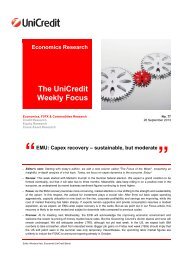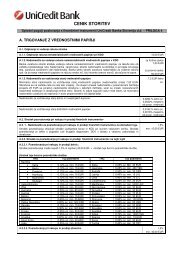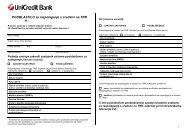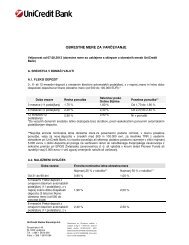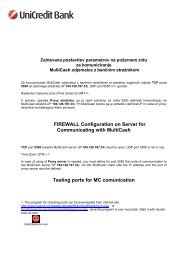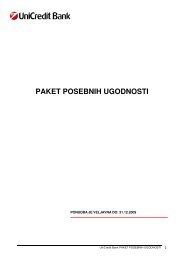Letno poroÄilo 2009.pdf - UniCredit Banka Slovenija dd
Letno poroÄilo 2009.pdf - UniCredit Banka Slovenija dd
Letno poroÄilo 2009.pdf - UniCredit Banka Slovenija dd
- No tags were found...
You also want an ePaper? Increase the reach of your titles
YUMPU automatically turns print PDFs into web optimized ePapers that Google loves.
Risk ReportRisk ReportCapital ManagementWithin the Internal Capital Adequacy Assessment Process (ICAAP), <strong>UniCredit</strong> <strong>Banka</strong> <strong>Slovenija</strong> d.d. focuses on the economic view of matchingthe economic capital (capital demand) with the risk-taking capacity (shareholder’s equity) in line with Pillar II of the Basel accord.The economic capital is calculated retrospectively on a quarterly basis but it is also monitored within the yearly planning process. As bothcapital demand and capital supply evolve over time, the Bank ensures that on the one side capital demand - mainly driven by business plansand by risk-profile forecasts in combination with macro-economic scenarios - does not exceed capital supply and on the other side the capitalsupply - mainly influenced by planned capital transactions and expected profits - is kept at a level to cover the calculated risks at all times.Economic capital is intended to reflect the Bank's specific risk profile in a comprehensive and consistent way. With the exception of liquidityrisk, economic capital is calculated using uniform value-at-risk methods across all types of risk which were mentioned in this risk report. Aspecific factor taken into account in the required risk capital is business risk, which reflects the influence of external factors such as consumerbehaviour or competitive situation on the market value of business divisions or subsidiaries. Unexpected losses over a period of one yearare calculated with a confidence level of 99.97 %. The overall responsibility for identification of risks and assessment of risk level is with theALCO.Besides the economic view, the Bank has to comply with the regulatory requirements set by Basel II and the Slovenian legislation. Here, theregulatory capital for credit risk, market risk and operational risk accounts for the capital demand, while balance-sheet capital (Tier 1, Tier 2and Tier 3) constitutes the capital supply side. Capital adequacy is monitored continuously by the Bank’s management and filed with the Bankof Slovenia on a quarterly basis. The Bank of Slovenia requires each bank to maintain a ratio of total regulatory capital to the risk weightedasset (the capital adequacy ratio) at or above the internationally agreed minimum of 8 %.The structure of the regulatory capital, capital requirements and capital adequacy ratio for 2009 and 2008 is presented in the table bellow. Thecapital adequacy ratio increased from 9.55 % at the end of 2008 to 10.29 % at the end of 2009. The Bank calculated the capital requirementfor operational risk according to the advance measurement approach at the end of 2009, whereas at the end of 2008 the Bank still used thestandardized approach.226 2009 Annual Report · <strong>UniCredit</strong> Bank



